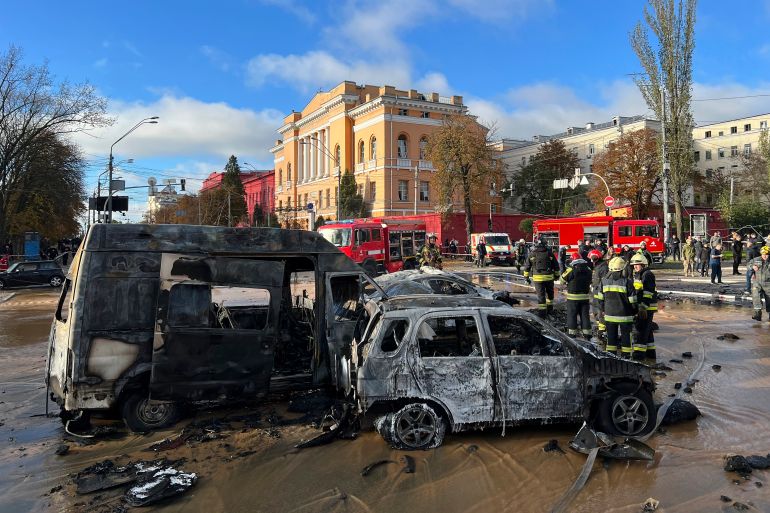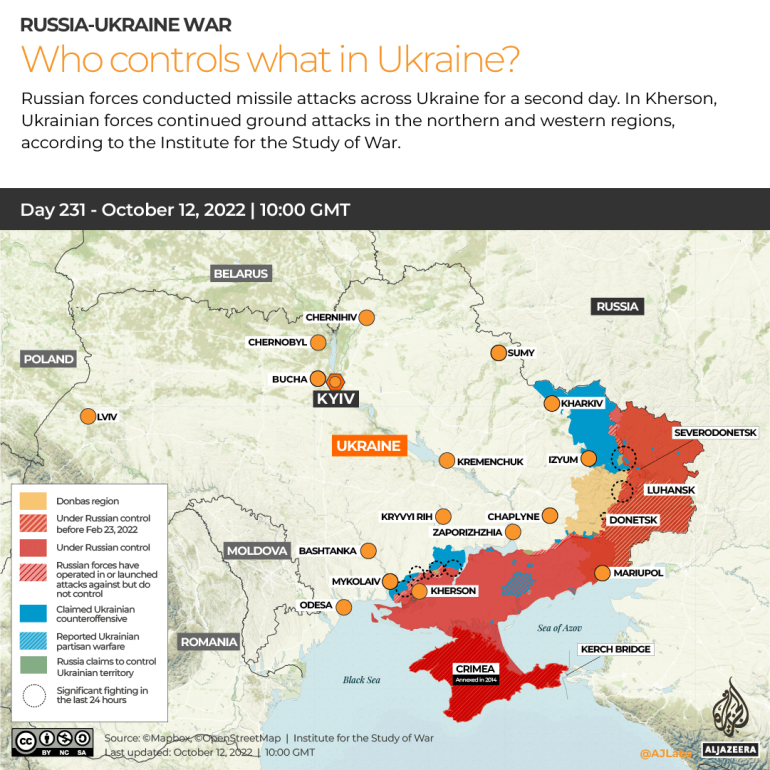Ukraine seeks weapons to counter Russia’s ability to strike
In the 33rd week of the war, Kyiv’s battlefield gains and the Kerch Bridge blast brings Russian retaliation on civilians and energy infrastructure.

An explosion on the Kerch Bridge connecting the Crimean Peninsula to Russia has led to massive Russian retaliation against Ukrainian civilians and infrastructure in the 33rd week of the war.
This, in turn, has led to Ukraine stepping up requests to allies for bolstered air defences and longer-range weapons with which to hit Russian forces.
Keep reading
list of 4 itemsAustralia may provide military training to Ukraine forces: PM
Russia-Ukraine war: List of key events, day 231
Russia arrests eight suspects over Crimea bridge blast
There are also ominous signs that Russia is enmeshing Belarus ever more closely in its war in Ukraine.
Kerch Bridge blast
On Saturday, an explosion on the bridge linking Russian-annexed Crimea with Russia disabled two of its four car lanes and melted tracks on a separate railway span, where a train caught fire.
Russia’s Investigative Committee said a truck had exploded on the bridge. Russia’s Federal Security Service pinned the attack on Ukraine’s military intelligence chief, Kyrylo Budanov.
Ukrainian officials celebrated the explosion but did not directly claim responsibility.
The damage is bound to create delays along a vital supply line for Russian materiel.
The Russian response to the blast came overnight, as missiles rained down on the city of Zaporizhzhia in south-central Ukraine, killing at least 12 people.
Then, on Monday, Russian missiles hit downtown Kyiv with an intensity not seen since the early days of the war and pounded towns and cities across Ukraine – hitting civilian targets, killing several people and wounding dozens.
Ukrainian energy minister Herman Halushchenko told CNN that 30 percent of Ukraine’s energy infrastructure had been hit, causing power outages and interruptions to the water supply.
“It will take months to repair the Lviv thermal power plants destroyed by Russia,” Lviv’s Mayor Andriy Sadovyi said during a briefing. “Four substations in the Lviv region are out of order, and to put them in order, not days, but months are needed. It is very complex equipment, transformers that are not available.”
“They want to destroy our energy system,” said Ukrainian President Volodymyr Zelenskyy. “The second target is people.”

Russian President Vladimir Putin said he was merely retaliating against Ukrainian attacks.
“If attempts [by Ukraine] to carry out terrorist attacks on our territory continue, Russia’s responses will be harsh and in scale will correspond to the level of threats posed by the Russian Federation,” Putin as saying.
The widespread Russian attacks were hailed by pro-Kremlin hawks, who called for more.
“If such actions to destroy the enemy’s infrastructure were taken every day, then we would have finished everything in May and the Kyiv regime would have been defeated,” Crimea’s Russian governor, Sergey Aksyonov, said.
Konstantin Dolgov, a former Russian commissioner for human rights, said there were “strikes against military infrastructure, the infrastructure of war. All of Ukraine’s plumbing isn’t working for civilians. It’s working for war.”
Calls for weaponry
Russia’s performance on the battlefield remains lacklustre amid a continuing Ukrainian counteroffensive, but its ability to attack deep into Ukraine has led to urgent calls by Kyiv to its allies for more advanced weaponry.
In a paper published in July, Ukrainian chief of staff Valery Zaluzhny said Russia’s weapons had a range of 2,000km (1,243 miles) compared with 100km (62 miles) for Ukraine’s.
“The crucial disproportion in capabilities is decisive,” Zaluzhny wrote along with parliamentarian Mykhailo Zabrodskyi.
“The enemy is capable of inflicting pinpoint strikes on targets in the entire depth of the country’s territory with impunity … As long as this situation persists, this war can continue for years.”
Ukraine’s general staff said they intercepted 46 cruise missiles and 27 unmanned aerial vehicles on Monday, but that Russian forces had launched 93 missile and air raids, and about 92 attacks from multiple launch rocket systems.
This would be an interception rate of 40 percent – much lower than the Ukrainian forces have proven themselves capable of in the past, suggesting their batteries may have been overwhelmed.
There have been some immediate responses by Ukraine’s allies. Germany rushed one unit of its state-of-the-art air defence system, the IRIS-T, to Ukraine. Germany had promised the systems on June 1.
The US promised to supply at least two National Advanced Surface-to-Air Missile Systems (NASAMS) to Ukraine.
Ukraine wants much more. The WSJ reported that Ukraine had requested long-range rocket artillery from the US, in order to hit Russian airfields in Crimea from which Iranian drones are being launched.
The Army Tactical Missiles System (ATACMS) missiles Ukraine requested have a 300km (186 miles) range and can be fired from the High Mobility Artillery Rocket Systems (HIMARS) launchers the US has already supplied, but only provided 80km (50-mile)-range ammunition for.
The Biden administration has been wary of escalating the conflict with weapons that could reach deep inside Russia.
Russia’s brutal new war commander
Meanwhile, Putin’s latest military shake-up suggests Ukraine may be in for much more bombardment.
On October 8, Putin appointed General Sergey Surovikin as commander of the war in Ukraine – the first military commander entitled to hold overall command for what Putin calls his “special military operation”.
Surovikin is a veteran of the Chechnya and Afghanistan wars. In 2017 and 2019 he commanded Russian troops in Syria, where he may have been the commander responsible for the indiscriminate bombing of Aleppo – in which Russia was accused of war crimes.
Surovikin was also briefly jailed on suspicion of ordering his men to fire on unarmed demonstrators in Moscow during the August 1991 coup that unseated Mikhail Gorbachev – a coup he backed along with other Soviet hardliners. Three demonstrators were killed.
In an article for the Spectator, historian Mark Galeotti described him as “combining competence with extreme ruthlessness. This is a man who regards terror as a legitimate, maybe even inevitable, part of war.”
As the first overall commander of the Ukraine war effort, Surovikin will now command Russia’s combined forces in the region; from cruise missile-equipped submarines to long-range bombers.
“That is likely to mean many more air raid sirens in towns and cities across Ukraine,” Galeotti concluded.
However, Ukraine has estimated that Russia is running low on precision cruise missiles like the Iskander and Kaliber, but has thousands of S-300 anti-air missiles it is repurposing to hit ground targets.
Putting the squeeze on Belarus
Ukraine expressed concern this week that Belarus may be pressed by Russia to directly enter the war.
“Russia is trying to directly draw Belarus into this war by playing a provocation that we [Ukraine] are preparing a strike,” Zelenskyy told a gathering of the G7 on Tuesday.
Zelenskyy proposed an international monitoring mission be deployed at the border to prevent any false flag operations.
Belarusian President Alexander Lukashenko had announced a day earlier that Belarus and Russia were starting to use a joint “regional grouping” of troops, agreed with Putin.
Until now, Ukrainian intelligence has assumed that Lukashenko is providing Russia with whatever it wants in return for staying out of the war.
In practice this has meant allowing 32 Iranian Shahed-136 kamikaze drones to be stationed in Belarus, six battalions of Russian special operations forces to sit at the Ukrainian border, and the repair of damaged Russian equipment.
It has also meant sales of ammunition and hardware to Russia. Ukraine’s General Staff said Belarusian authorities removed the first batch of 20 T-72 tanks from storage and sent them to Russia on October 12. The assumption is they would be refurbished and used in Ukraine.
Ukraine’s military intelligence also said it tracked a train cargo of suspected ammunition and vehicles weighing 492 tonnes from Belarus to Kirovskaya station in Crimea, and said 13 more trainloads of Belarusian equipment and ammunition are due to be sent.